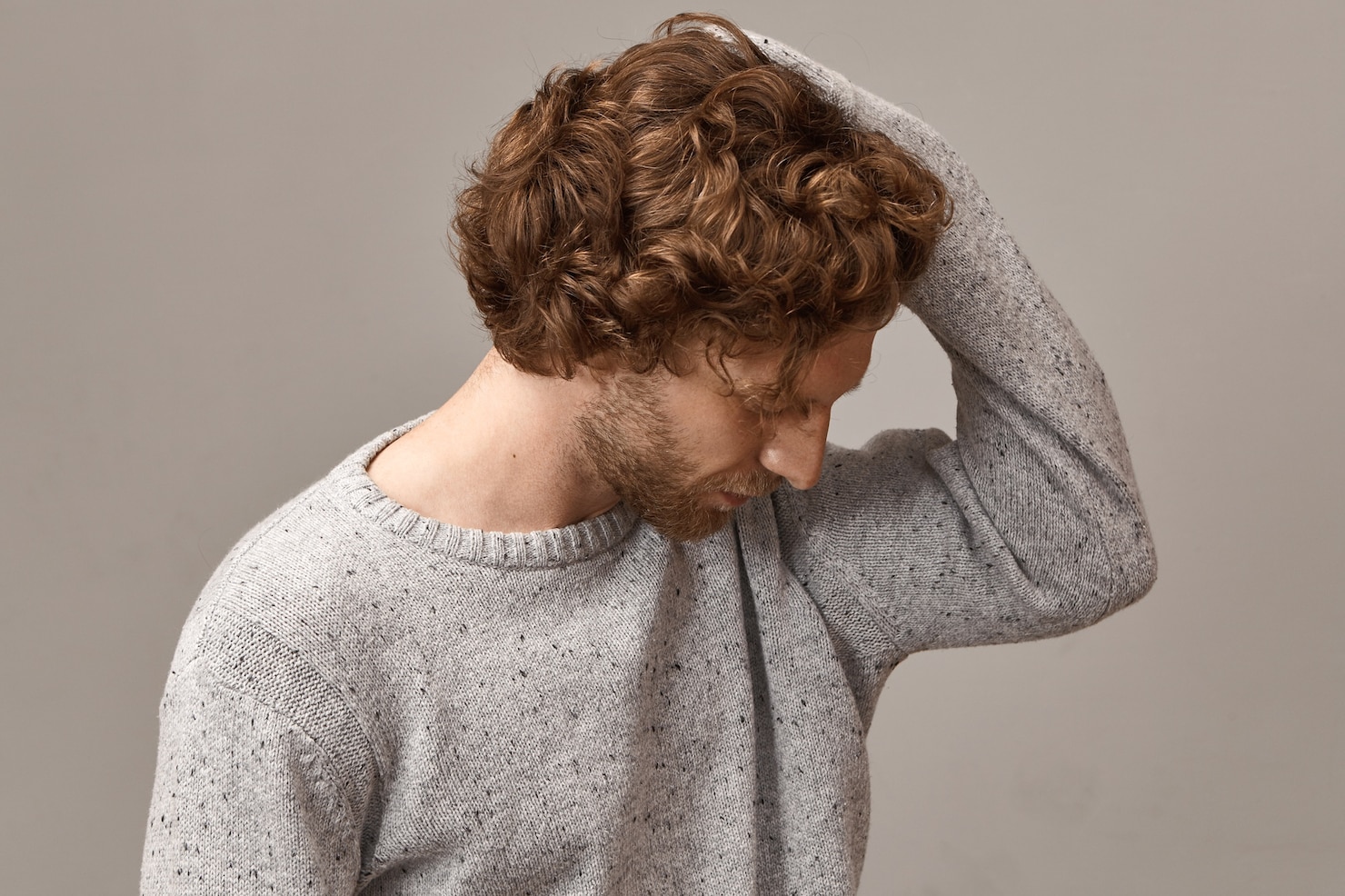
Are you tired of struggling with stubborn knots in your hair? Don't worry, we've got you covered! In this comprehensive guide, we will walk you through effective techniques on how to get knots out of hair effectively.
Whether you're dealing with tangles, snarls, or matted hair, our expert tips and insights will empower you to achieve smoother, healthier-looking hair. With that, you no longer need to endlessly search for terms such as “how to get really bad knots out of hair,” “how to get knots out of hair home remedies,” or “how to get knots out of your hair.”
Say goodbye to the frustration of tangled locks and hello to a hassle-free hair care routine. Let's dive in!
About Hair Knots
Hair knots can be a frustrating and common issue for men, especially when you have curly, long hair, leading to tangled and unruly locks. Understanding the definition, causes, and impact of hair knots is essential in tackling this problem effectively.
Definition and causes of hair knots
Hair knots occur when individual strands of hair intertwine and form tight, tangled clusters. These knots can be caused by various factors, including dryness, lack of proper hair care, and excessive friction. Dry, damaged, and brittle hair is more prone to tangling, as the lack of moisture reduces the hair's flexibility and increases the chances of strands intertwining. Additionally, rough handling, such as vigorous brushing or combing, can further exacerbate knot formation.
Impact of hair knots on men's hair health
Hair knots not only contribute to a disheveled appearance but can also have negative consequences for overall hair health. When hair is tangled and knotted, it becomes more susceptible to breakage and split ends. The tight knots put a strain on the hair shaft, leading to weak and damaged strands. This can hinder hair growth and result in the appearance of thinner, less voluminous hair. Moreover, the constant pulling and tugging required to remove knots can cause additional stress to the hair, leading to further breakage and potential hair loss. If you avoid or postpone detangling those knots, the hair can be further tangled and matted which can worsen hair breakage and split ends.
Key Takeaway:
Understanding the definition and causes of hair knots is crucial for implementing effective strategies to manage and prevent them. By addressing dryness, practicing proper hair care techniques, and minimizing friction, you can maintain healthier, knot-free hair and promote optimal hair growth.Understanding Hair Structure
To effectively address hair knots, it's essential to delve into the intricate structure of your hair. By familiarizing yourself with the anatomy of hair strands and the factors that contribute to knot formation, you can develop a tailored approach to manage and prevent tangles.
Anatomy of hair strands
Each hair strand consists of three primary layers: the cuticle, cortex, and medulla.The outermost layer, the cuticle, is composed of overlapping scales that protect the inner layers, especially the cortex. When the cuticle is damaged or lifted, it becomes more prone to snagging and tangling. The cortex, located beneath the cuticle, provides the hair's strength, elasticity, texture, and color. Lastly, the medulla, found only in thicker hair strands, is extremely thin and fragile.

Factors contributing to hair knot formation
Several factors can contribute to the formation of hair knots. Dryness is a common culprit, as lack of moisture reduces the hair's natural lubrication and makes it more susceptible to tangling. Dry and matted hair is more prone for knots than healthy, shiny, rejuvenated hair. If your hair is curly, coily, kinky or long it can easily get knotted. Additionally, rough handling, such as excessive brushing, rubbing hair with a towel can disrupt the hair cuticle and cause strands to intertwine. Manipulating hair while shampooing and styling can also form knots. Damaged hair (heat, color and product damaged hair) commonly get knots. Textured hair (when the cuticle of the hair strand is textured and damaged, it increases the risk of getting knots and attracting more strands to the knot, making them bigger. Environmental elements like wind, humidity, and friction from pillowcases or clothing can further exacerbate knot formation. Environmental elements like wind, humidity, and friction from pillowcases or clothing can further exacerbate knot formation.
Key Takeaway:
By understanding the complex structure of your hair strands and the factors that contribute to knot formation, you can implement targeted strategies to prevent and manage tangles. Ensure your hair receives adequate moisture, use gentle brushing techniques, and minimize exposure to environmental factors that increase friction. By treating your hair with care and respecting its natural structure, you can maintain smoother, tangle-free hair.Importance of Proper Hair Care Routine

Image Source: FreePik
Maintaining a proper hair care routine is crucial for the health and appearance of your hair. By incorporating regular cleansing and conditioning as well as avoiding excessive heat and chemical treatments, you can promote the longevity and vitality of your locks.
Regular cleansing and conditioning
Regular cleansing and conditioning play a vital role in keeping your hair healthy and free from knots. Choose a gentle shampoo that suits your hair type and thoroughly cleanse your scalp and strands to remove dirt, excess oil, and product buildup. Always detangle hair with your fingers or a wide toothed comb before you shampoo. Follow up with a nourishing conditioner to restore moisture, enhance manageability, and minimize tangles. It's important to note that over-washing can strip the hair of its natural oils, leading to dryness and increased knot formation. Finding the right balance and frequency of cleansing and conditioning is key. Go for deep conditioning treatments regularly. When you apply conditioner, use the prayer method. That is smoothing the product from root to end, using your palms. Use hair masks packed with moisture to provide your hair enough hydration to prevent knots.
Avoiding excessive heat and chemical treatments
Excessive heat styling and chemical treatments can wreak havoc on your hair, making it more prone to tangles and damage. The heat from blow dryers, flat irons, and curling irons can deplete moisture from the hair, leaving it dry and brittle. Opt for heat-protectant products before using styling tools and adjust the heat settings to minimize the potential for damage. Similarly, chemical treatments like perming, relaxing, or coloring can damage and weaken the hair shaft, making it more susceptible to knots. If possible, limit the frequency of these treatments and ensure you're using products specifically designed for your hair type.
Key Takeaway:
Maintaining a proper hair care routine is essential in preventing knot formation and promoting the overall health of your hair. By regularly cleansing and conditioning your hair with suitable products, you can keep it nourished and manageable. Additionally, avoiding excessive heat and chemical treatments will help protect your hair from damage and minimize the occurrence of tangles. Remember, a consistent and gentle approach to hair care will go a long way in achieving smooth, knot-free hair.Tips for Preventing Hair Knots

Image Source: FreePik
Preventing hair knots is key to maintaining smooth and manageable hair. By following these essential tips, including regular trimming to remove split ends and utilizing the right products, you can significantly reduce knot formation and promote healthier hair.
Regular trimming to remove split ends
Regular trimming is a crucial step in preventing hair knots. Split ends tend to snag and tangle with the surrounding hair, leading to more knots and potential breakage. By trimming your hair every 6-8 weeks, you can remove split ends and prevent them from traveling up the hair shaft. This helps maintain the overall health of your hair, making it less prone to tangling. Consulting with a professional stylist will ensure that you receive a precise and effective trim.
Products to Consider
When it comes to preventing hair knots, choosing the right hair products can make a significant difference in maintaining smooth and manageable locks. Here are some specific ingredients to look for that can help avoid hair knots:
Conditioning agents:
Look for products that contain effective conditioning agents like silicone derivatives (such as dimethicone) and natural oils (such as argan oil or coconut oil). These ingredients provide moisture and lubrication to the hair, making it less prone to tangling and easier to comb through.Hydrolyzed proteins:
Hydrolyzed proteins, such as hydrolyzed wheat protein or hydrolyzed keratin, can help strengthen the hair shaft and reduce breakage. By fortifying the hair, these proteins minimize the occurrence of split ends and prevent knots from forming.Detangling agents:
Seek out hair products that specifically mention detangling properties. Ingredients like panthenol, glycerin, shea butter, silicon, or quaternary ammonium compounds (such as behentrimonium chloride) are known for their ability to smooth out knots and tangles, making the hair easier to manage.
Braiding or twisting your hair before going to bed minimizes friction. Use a silk or satin pillowcase or a scarf for bed.
Key Takeaway:
Preventing hair knots requires a combination of regular maintenance and using the appropriate products. Remember to schedule regular trims to remove split ends and keep your hair in optimal condition. Utilize lightweight conditioners, leave-in products, and suitable brushes or combs to keep your hair moisturized and detangled. By implementing these preventive measures, you can enjoy smoother, knot-free hair and promote overall hair health.How to detangle hair knots
Use detangle spray, water or mineral oils to make detangling easier.
Work in sections of hair
Use a wide toothed comb to gently brush through hair. Start from the ends and work your way up to the roots.
Use detangling tools when necessary.
Conclusion
Say goodbye to the frustration of tangled locks and hello to smooth, manageable hair. By following the tips and techniques outlined in this guide, you can achieve the hair of your dreams. No more endless searches for solutions to knots—now you have the knowledge and tools to address this common issue.
Proper care, including regular cleansing and conditioning, is vital for maintaining healthy and knot-free hair. Avoiding excessive heat and chemical treatments will protect your hair from damage and minimize tangles. Additionally, incorporating regular trimming and using the right products can significantly reduce knot formation.
Remember, your hair deserves the best care. Treat it with love, respect its natural structure, and nourish it with the right products. By embracing a consistent and gentle approach to hair care, you can enjoy tangle-free locks that radiate health and vitality.
So, take charge of your hair care routine and say goodbye to knots. Embrace the journey to effortlessly beautiful hair!
